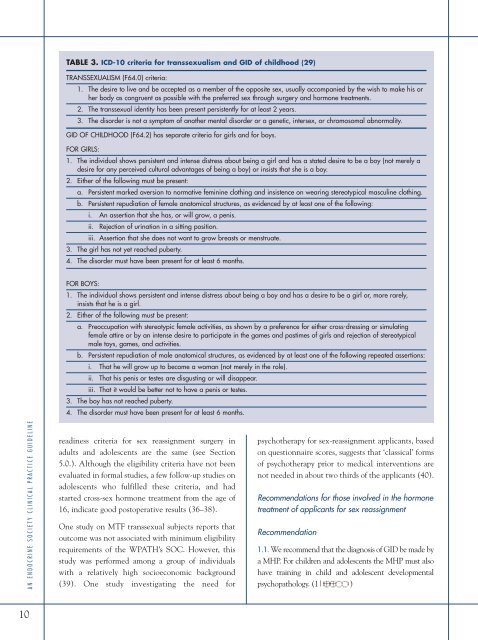endocrine-treatment-of-transsexual-persons
endocrine-treatment-of-transsexual-persons
endocrine-treatment-of-transsexual-persons
You also want an ePaper? Increase the reach of your titles
YUMPU automatically turns print PDFs into web optimized ePapers that Google loves.
AN ENDOCRINE SOCIETY CLINICAL PRACTICE GUIDELINE<br />
10<br />
TABLE 3. ICD-10 criteria for <strong>transsexual</strong>ism and GID <strong>of</strong> childhood (29)<br />
TRANSSEXUALISM (F64.0) criteria:<br />
1. The desire to live and be accepted as a member <strong>of</strong> the opposite sex, usually accompanied by the wish to make his or<br />
her body as congruent as possible with the preferred sex through surgery and hormone <strong>treatment</strong>s.<br />
2. The <strong>transsexual</strong> identity has been present persistently for at least 2 years.<br />
3. The disorder is not a symptom <strong>of</strong> another mental disorder or a genetic, intersex, or chromosomal abnormality.<br />
GID OF CHILDHOOD (F64.2) has separate criteria for girls and for boys.<br />
FOR GIRLS:<br />
1. The individual shows persistent and intense distress about being a girl and has a stated desire to be a boy (not merely a<br />
desire for any perceived cultural advantages <strong>of</strong> being a boy) or insists that she is a boy.<br />
2. Either <strong>of</strong> the following must be present:<br />
a. Persistent marked aversion to normative feminine clothing and insistence on wearing stereotypical masculine clothing.<br />
b. Persistent repudiation <strong>of</strong> female anatomical structures, as evidenced by at least one <strong>of</strong> the following:<br />
i. An assertion that she has, or will grow, a penis.<br />
ii. Rejection <strong>of</strong> urination in a sitting position.<br />
3.<br />
iii. Assertion that she does not want to grow breasts or menstruate.<br />
The girl has not yet reached puberty.<br />
4. The disorder must have been present for at least 6 months.<br />
FOR BOYS:<br />
1. The individual shows persistent and intense distress about being a boy and has a desire to be a girl or, more rarely,<br />
insists that he is a girl.<br />
2. Either <strong>of</strong> the following must be present:<br />
a. Preoccupation with stereotypic female activities, as shown by a preference for either cross-dressing or simulating<br />
female attire or by an intense desire to participate in the games and pastimes <strong>of</strong> girls and rejection <strong>of</strong> stereotypical<br />
male toys, games, and activities.<br />
b. Persistent repudiation <strong>of</strong> male anatomical structures, as evidenced by at least one <strong>of</strong> the following repeated assertions:<br />
i. That he will grow up to become a woman (not merely in the role).<br />
ii. That his penis or testes are disgusting or will disappear.<br />
3.<br />
iii. That it would be better not to have a penis or testes.<br />
The boy has not reached puberty.<br />
4. The disorder must have been present for at least 6 months.<br />
readiness criteria for sex reassignment surgery in<br />
adults and adolescents are the same (see Section<br />
5.0.). Although the eligibility criteria have not been<br />
evaluated in formal studies, a few follow-up studies on<br />
adolescents who fulfilled these criteria, and had<br />
started cross-sex hormone <strong>treatment</strong> from the age <strong>of</strong><br />
16, indicate good postoperative results (36–38).<br />
One study on MTF <strong>transsexual</strong> subjects reports that<br />
outcome was not associated with minimum eligibility<br />
requirements <strong>of</strong> the WPATH’s SOC. However, this<br />
study was performed among a group <strong>of</strong> individuals<br />
with a relatively high socioeconomic background<br />
(39). One study investigating the need for<br />
psychotherapy for sex-reassignment applicants, based<br />
on questionnaire scores, suggests that ‘classical’ forms<br />
<strong>of</strong> psychotherapy prior to medical interventions are<br />
not needed in about two thirds <strong>of</strong> the applicants (40).<br />
Recommendations for those involved in the hormone<br />
<strong>treatment</strong> <strong>of</strong> applicants for sex reassignment<br />
Recommendation<br />
1.1. We recommend that the diagnosis <strong>of</strong> GID be made by<br />
a MHP. For children and adolescents the MHP must also<br />
have training in child and adolescent developmental<br />
psychopathology. (1| )


